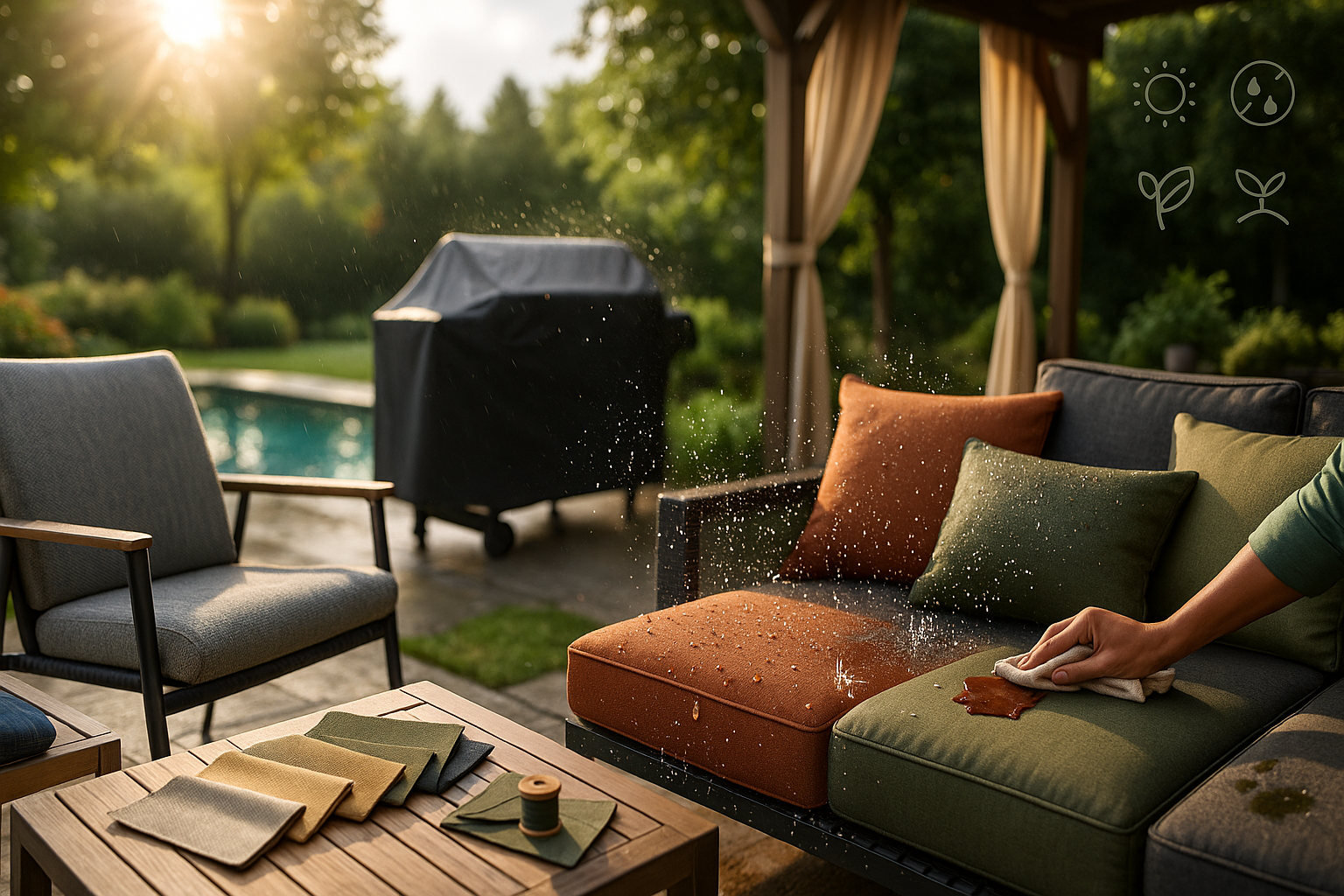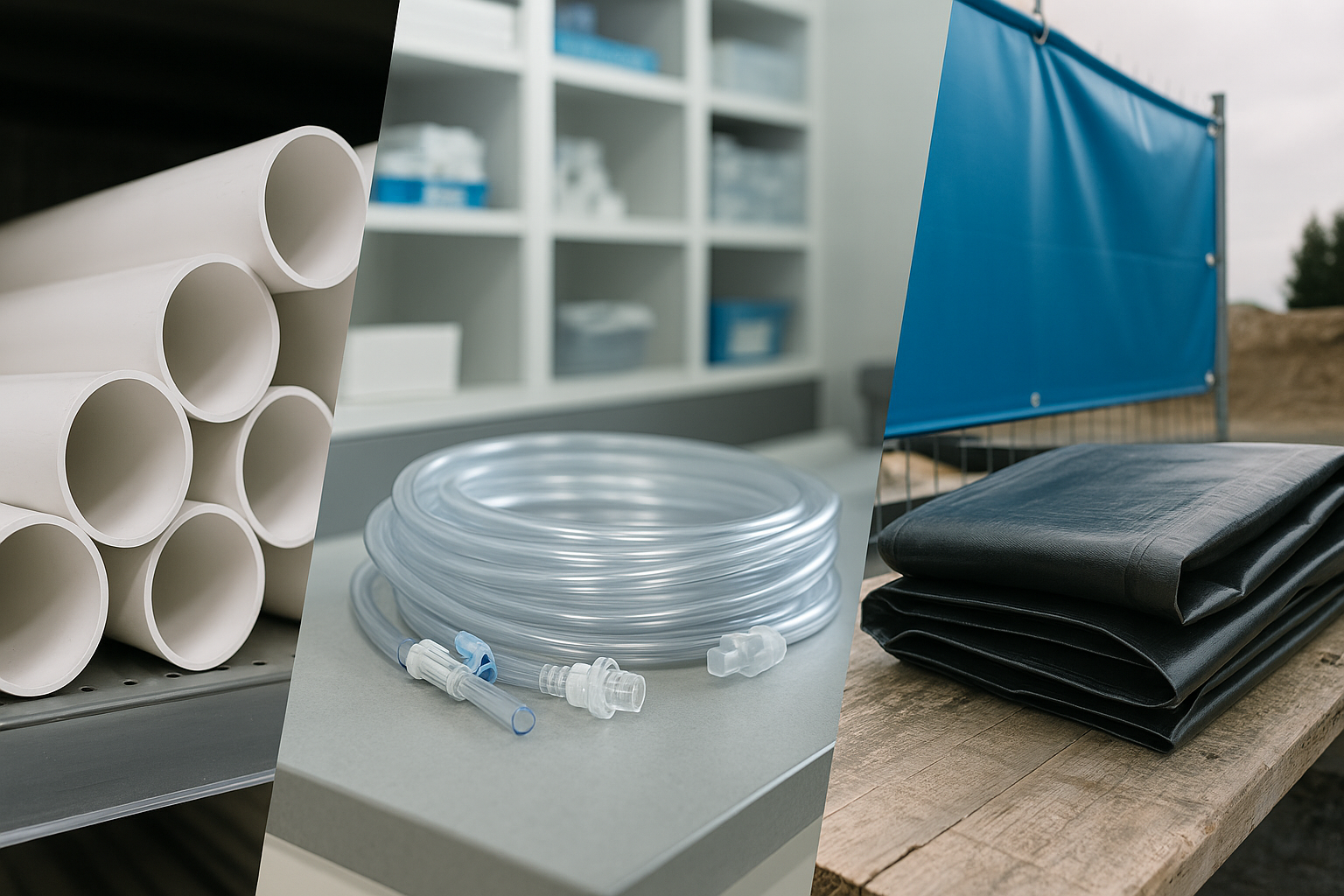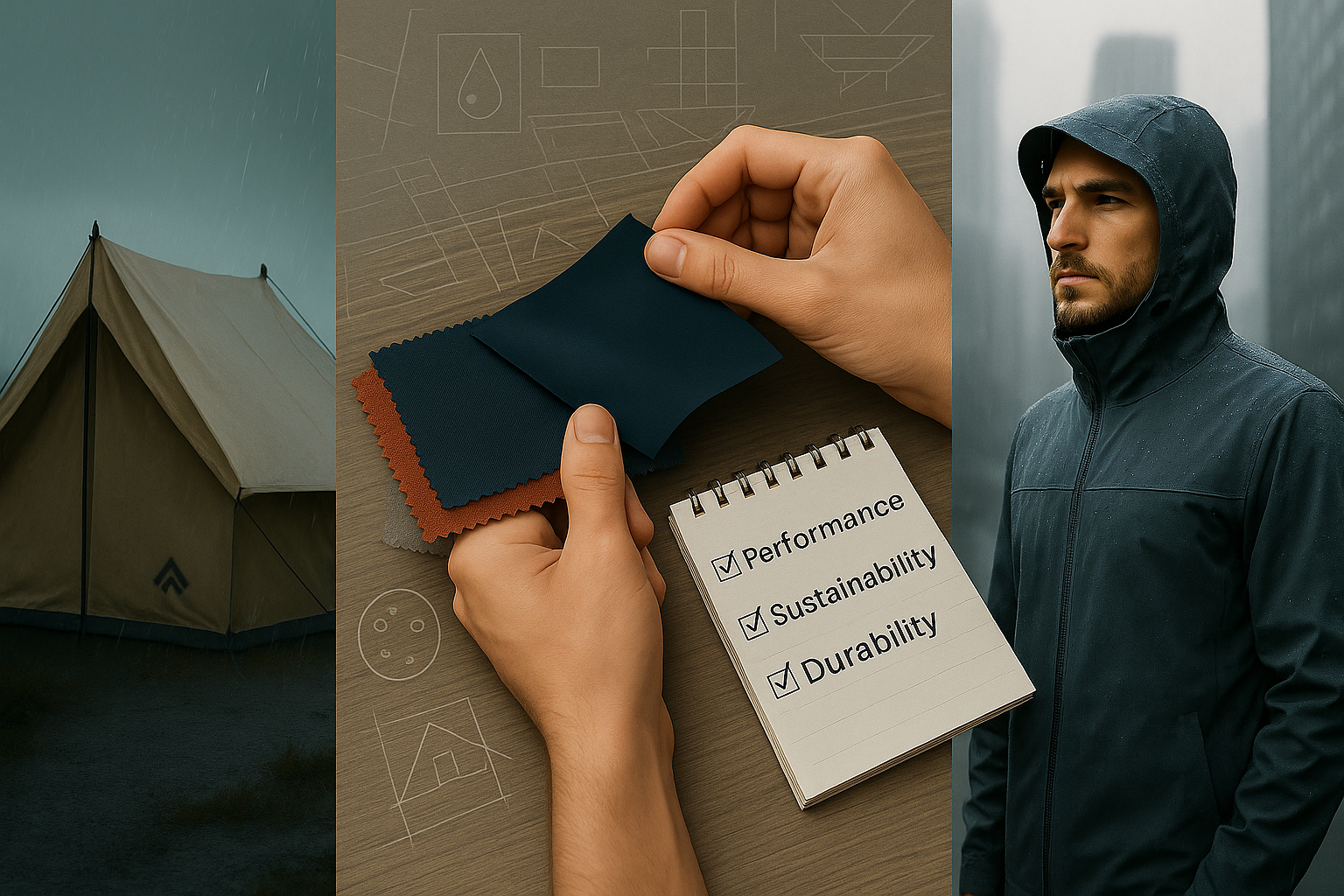
When selecting materials for outdoor, industrial, or technical applications, understanding the difference between “waterproof” and “water resistant” can make or break the success of your project.
While these terms are often used interchangeably, they represent distinct performance characteristics that impact durability, longevity, and overall suitability for specific environments.
Whether you’re designing a tarp, protective cover, or fabric-based solution, choosing the right level of water protection isn’t just a matter of semantics—it’s a strategic decision.
In this article, we’ll:
- break down what each term truly means
- explore how they perform under real-world conditions
- guide you through the key considerations
…to help you determine which option best meets the demands of your application
How Are Waterproof & Water-Resistant Fabrics Different? 2 Key Measurements

The terms “waterproof” and “water resistant” both describe how well a material can handle exposure to water—but they have very different levels of protection. Here’s a detailed breakdown:
1. What Does Water Resistant Mean?
In industrial use, “water resistant” refers to materials or systems that can tolerate some degree of moisture or splashing, but are not designed for continuous exposure or pressure from water. Water resistant materials are often woven textiles with a DWR (Durable Water Repellent) coating. Exposure to sustained water (e.g., storms, flooding, pressure washing) can lead to seepage, fabric saturation, or coating breakdown.
Advantages:
- Water resistant fabrics—especially those with permeable membranes or woven structures—can allow for air and vapor exchange.
- These fabrics are generally lighter and more maneuverable than fully waterproof materials
- Because they use less coating or fewer layers than waterproof textiles, they are often more affordable.
- Water resistant fabrics do not absorb water easily, and even when they get wet, they dry faster than heavier waterproof textiles
Use Cases:
- Covers or tarps that protect equipment from light rain or mist.
- Coated fabrics used for short-term outdoor storage.
- Machinery enclosures with vented panels or treated surfaces.
Performance Limitations:
- Exposure to sustained water (e.g., storms, flooding, pressure washing) can lead to seepage, fabric saturation, or coating breakdown.
- May require frequent reapplication of repellents or drying time.
2. What Does Waterproof Mean?
“Waterproof” in an industrial setting means the material or system completely blocks water ingress, even under pressure, immersion, or long exposure. Heat-welded seams, gaskets, or lamination for fully sealed construction are often needed. There are a variety of specifications by industry, but some standards for comparison include ASTM D751, IP Ratings, or ISO 811 for hydrostatic resistance.
Advantages:
- Withstanding high pressure washing, storms, immersion.
- Excellent for outdoor, marine, or chemical containment uses.
- More durable and low maintenance compared to water-resistant options.
Use Cases:
- Long-term outdoor storage and containment.
- Washdown areas in food or pharma manufacturing.
- Agricultural pond liners, grain covers, or silage bags.
- Flexible ducts and tents in mining or oil & gas sectors.
Performance Limitations:
- The impermeability of waterproof fabrics keeps water out, but also makes them impenetrable to air and vapor, which means no breathability.
- Many waterproof fabrics use multi-layered constructions or thick polymer coatings making them heavier and harder to handle. This can increase transportation costs and labor effort.
- Some waterproof materials, especially PVC-based fabrics, tend to become rigid or brittle in cold temperatures. This reduces their flexibility, increases the risk of cracking, and makes them harder to work with in winter or in cold storage environments.
- Compared to water resistant alternatives, waterproof fabrics are typically more expensive to manufacture (due to coatings, sealing methods, and reinforcements), which makes them pricier upfront, especially for large-area coverage.
Renegade’s Waterproof Fabric at Water-Resistant Weight
Renegade Plastics has redefined performance standards in coated fabrics with its innovative waterproof textiles that deliver full protection without the bulk.
Traditionally, achieving true waterproofing has meant compromising on weight, flexibility, or sustainability—but not anymore. Renegade’s technology results in a fabric that offers airtight and waterproof capabilities while maintaining the lightweight characteristics typically found only in water-resistant materials.
This breakthrough allows manufacturers and product designers to eliminate heavy, cumbersome layers without sacrificing performance, making it ideal for applications like tarpaulins, shade structures, and protective covers.
By combining strength, barrier protection, and ease of handling, Renegade’s waterproof fabric empowers industries to elevate both function and efficiency.
7 Key Examples of Waterproof/Water Resistant Fabric
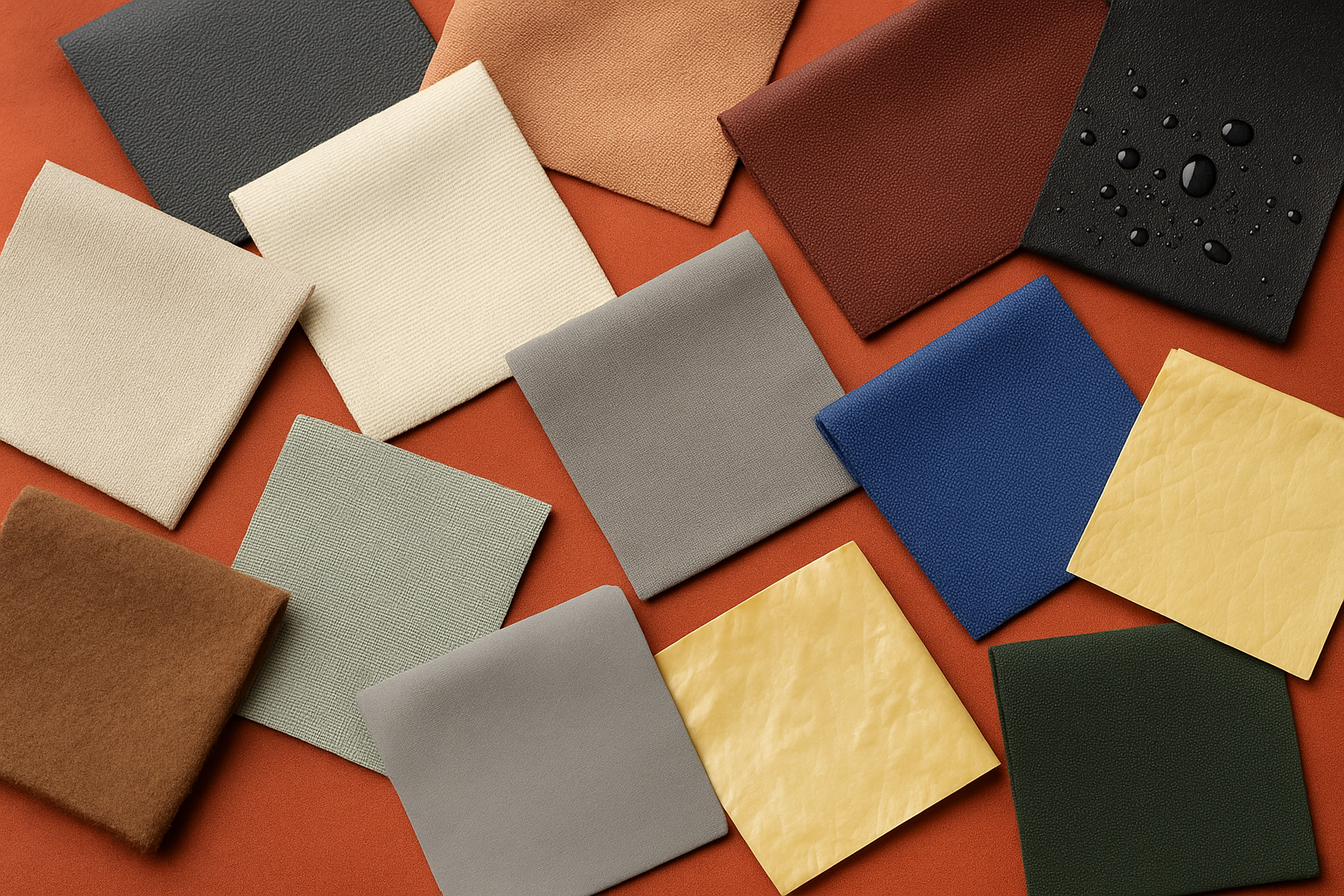
When it comes to protecting against moisture, not all fabrics are created equal. From rugged industrial use to lightweight outdoor gear, the market offers a wide variety of material technology to repel or block water in different ways. Below are seven common types of waterproof or water-resistant fabrics—each with unique properties, advantages, and ideal applications—to help you better understand which material best suits your specific needs.
1. Coated Polypropylene
A newcomer to the waterproof fabrics market, Renegade’s coated woven polypropylene is making a splash – without getting wet. Polypropylene is naturally hydrophobic and our coating process is designed to create a smooth and impenetrable layer to water. Coated polypropylene is also tear resistant and has excellent resistance to solvents, sunlight, ozone exposure, and petroleum products. The perfect durable fabric for almost any outdoor application.
2. Vinyl (PVC)
Vinyl fabrics are incredibly waterproof due to the layers of PVC that are applied to a base fabric – typically polyester, cotton, or a cotton/poly blend. A PVC layer can be applied to one or both sides of the fabric to create a durable and impenetrable layer. The downside is that vinyl fabrics are non-recyclable, contain toxic plasticizers, have a high carbon footprint, and are not breathable. Think of those yellow vinyl raincoats from childhood where you sweat so much there was more water inside the coat than outside.
3. Polyurethane coatings
Polyurethane (PU) coatings are often added to a textile material – usually polyester, nylon, or canvas—that has been coated or laminated with a thin layer of PU to provide water repellency, durability, and flexibility. Since PU is inherently hydrophobic it blocks water penetration through the surface. While more sustainable than PVC, PU has a high carbon footprint, is not breathable, and is not able to be recycled.
4. Latex & Natural Rubber
Natural rubber is derived from latex that is extracted from rubber trees. It is resistant to water; however, it deteriorates when exposed to oil, field, solvents, and hydraulic fluids. Rubber products that will be exposed to sunlight, ozone, and/or high temperatures are often made with additives to increase product longevity and reduce cracking.
5. Synthetic Rubbers
There are a variety of synthetic rubbers each with specifically tuned properties. For water resistance, the best options are butyl rubber, EPDM, and silicone. However, EPDM is not good for use with petroleum oils, fluids, or solvents due to swelling. Silicone has poor tensile strength, and poor abrasion and tear resistance.
6. Gore-tex®
Gore-tex is the most well-known brand name for laminated fabrics. Laminated fabrics have a waterproof membrane laminated between two layers of fabric. These fabrics are breathable and lightweight, but be careful of additives like PFAS that may be added to enhance water resistance.
7. Polyester
Polyester is not naturally waterproof, but it is inherently water-resistant to a degree due to its synthetic hydrocarbon-based structure. The final water resistance or waterproofness of polyester products depends heavily on fabric construction and treatments or coatings applied during manufacturing.
8. Nylon
Similar to polyester, nylon is inherently water-resistant but to a lesser extent. In order to achieve improved water resistance, nylon is often woven in a ripstop weave, treated with durable water repellant (DWR), or coated with another polymer that is more hydrophobic.
Choosing the Right Waterproof or Water-Resistant Fabric: Performance Comparison & Testing Methods
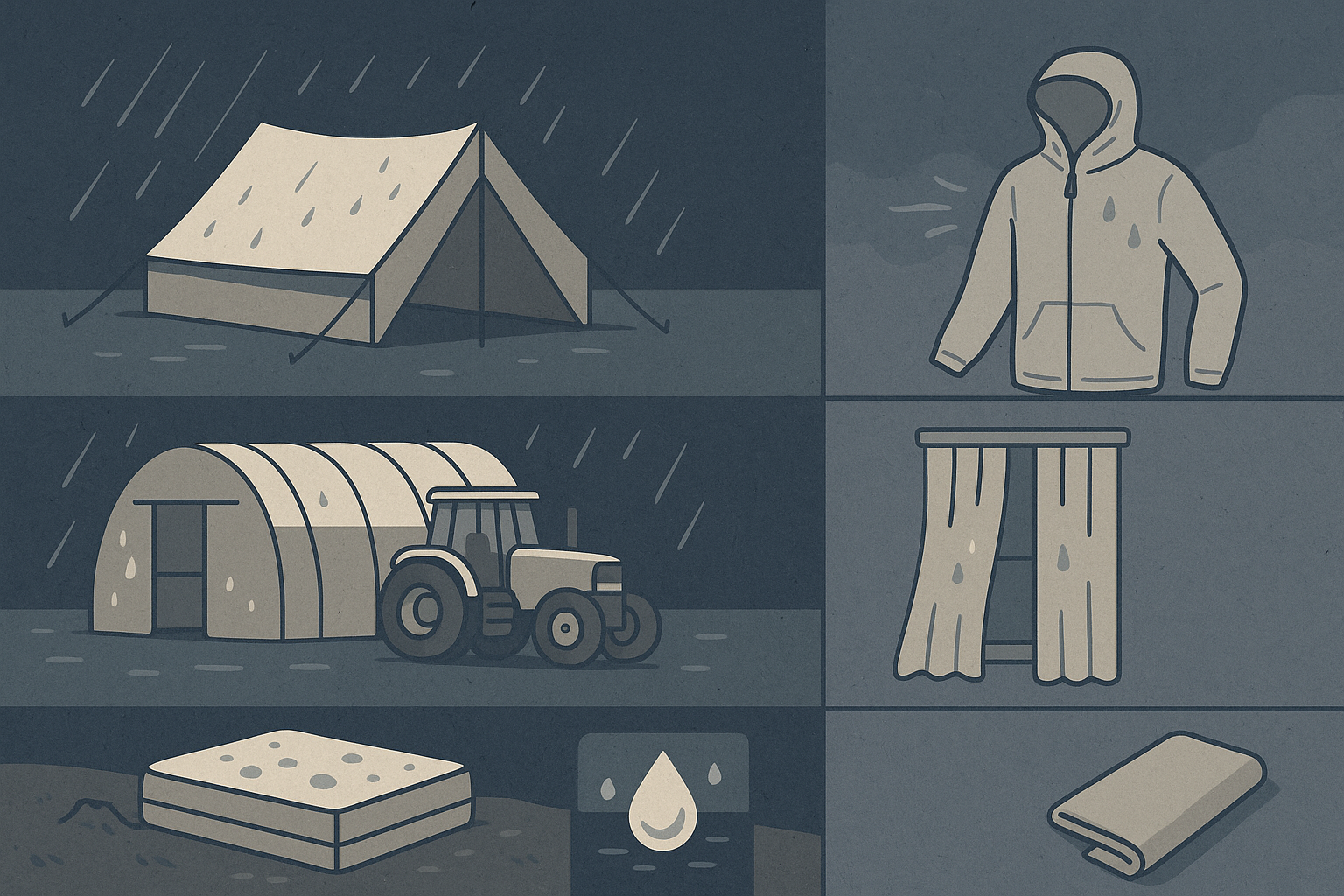
When selecting a fabric for applications requiring moisture protection and prolonged exposure to the elements, it’s not enough to consider whether a material is waterproof or water-resistant.
Performance characteristics like:
- durability
- UV resistance
- chemical resistance
- flexibility
- cold tolerance
…also play critical roles in determining suitability for your environment and use case.
The table below compares Renegade’s waterproof fabric to commonly used waterproof or water-resistant materials—such as vinyl, polyurethane-coated nylon, latex/natural rubber, synthetic rubber, Gore-Tex®, polyester, and nylon—across five key performance characteristics.
To provide transparency and technical rigor, we’ve also included recognized test methods that evaluate each property.
Overview of 5 Test Methods by Characteristic:
- Waterproof/Water-Resistant:Example Tests: AATCC 127, ASTM D751
These tests measure a fabric’s hydrostatic resistance—how much water pressure it can withstand before leaking. - Durability:Example Tests: ASTM D751, ASTM D5034, ASTM D2261
Assess tensile strength, tear resistance under stress or load, and puncture resistance. - UV Resistance:Example Tests: ASTM G154, AATCC TM16
Simulate long-term UV exposure to evaluate fading, weakening, and surface degradation. - Chemical Resistance:Example Test: ASTM D543
Measures a material’s ability to withstand exposure to acids, bases, and other chemicals without degrading. - Cold Tolerance:Example Test: ASTM D2136
Measures the ability of materials to bend or flex at sub-zero temperatures without cracking.
| Fabric Type | Category | Weight | Durability | UV Resistance | Chemical Resistance | Cold Tolerance |
|---|---|---|---|---|---|---|
| Renegade | Waterproof | Light | High | Excellent | Excellent | Excellent |
| Vinyl | Waterproof | Heavy | Very High | Moderate | Excellent | Moderate |
| PU-Coated Nylon | Water-Resistant | Light | Moderate | Moderate | Moderate | Moderate |
| Latex & Natural Rubber | Waterproof | Medium | Moderate | Low | Low | Poor |
| Synthetic Rubber | Waterproof | Medium | High | Good | Good | Excellent |
| Gore-Tex® | Waterproof | Light | High | Excellent | Excellent | Excellent |
| Polyester | Water-Resistant | Light | Moderate | Moderate | Moderate | Moderate |
| Nylon | Water-Resistant | Light | Moderate | Moderate | Moderate | Moderate |
5 Questions & Answers About Waterproof Textiles For Heavy-Duty Use
Have questions about waterproof and water-resistant fabrics, how to choose the right material, or what makes Renegade’s fabric different?
This FAQ section addresses the most common inquiries we hear from manufacturers, designers, and industry professionals. Whether you’re looking for technical clarifications or practical guidance, you’ll find straightforward answers below.
1. Can I sew waterproof fabrics to make my end product?
Yes, but keep in mind that waterproof fabrics need to have fabrication methods that do not degrade the waterproofness. Sewing without additional reinforcement introduces small holes or conduits for water to be able to penetrate through the fabric. Renegade fabrics are compatible with sewing along with hot welding or impulse welding techniques making them ideal for waterproof fabrication.
2. Which waterproof fabric is best for heavy-duty outdoor use?
For high-performance industrial use—such as truck tarps, construction covers, or containment liners—materials like vinyl-coated polyester, synthetic rubbers (e.g., EPDM, Neoprene), or engineered options like Renegade’s coated fabrics offer excellent strength, UV resistance, and full waterproofing. Selection depends on the specific use case and environmental exposure.
3. How do I ensure chemical resistance in waterproof fabric for industrial environments?
Look for materials that have been tested under ASTM D543 or equivalent chemical exposure standards. Vinyl, some synthetic rubbers, and Renegade’s coated fabrics often have strong resistance to oils, acids, and solvents—critical for chemical manufacturing, agriculture, or waste handling applications.
4. Do all waterproof fabrics have added PFAS?
No! Renegade’s entire portfolio is free of intentionally added PFAS*, giving you peace of mind that your products are dry and free of “forever” chemicals. Gore-Tex also has some product offerings that are PFAS-free and suitable for a variety of apparel applications.
5. Can waterproof or water-resistant fabrics be environmentally friendly?
Yes, but it depends on the material. Some fabrics—like Renegade’s coated textiles—are designed to be recyclable and free from harmful chemicals like phthalates or heavy metals. Sustainability also depends on the base polymer, production process, and whether the fabric can be reused or recycled at end-of-life.
Waterproof Fabrics – Without the Weight
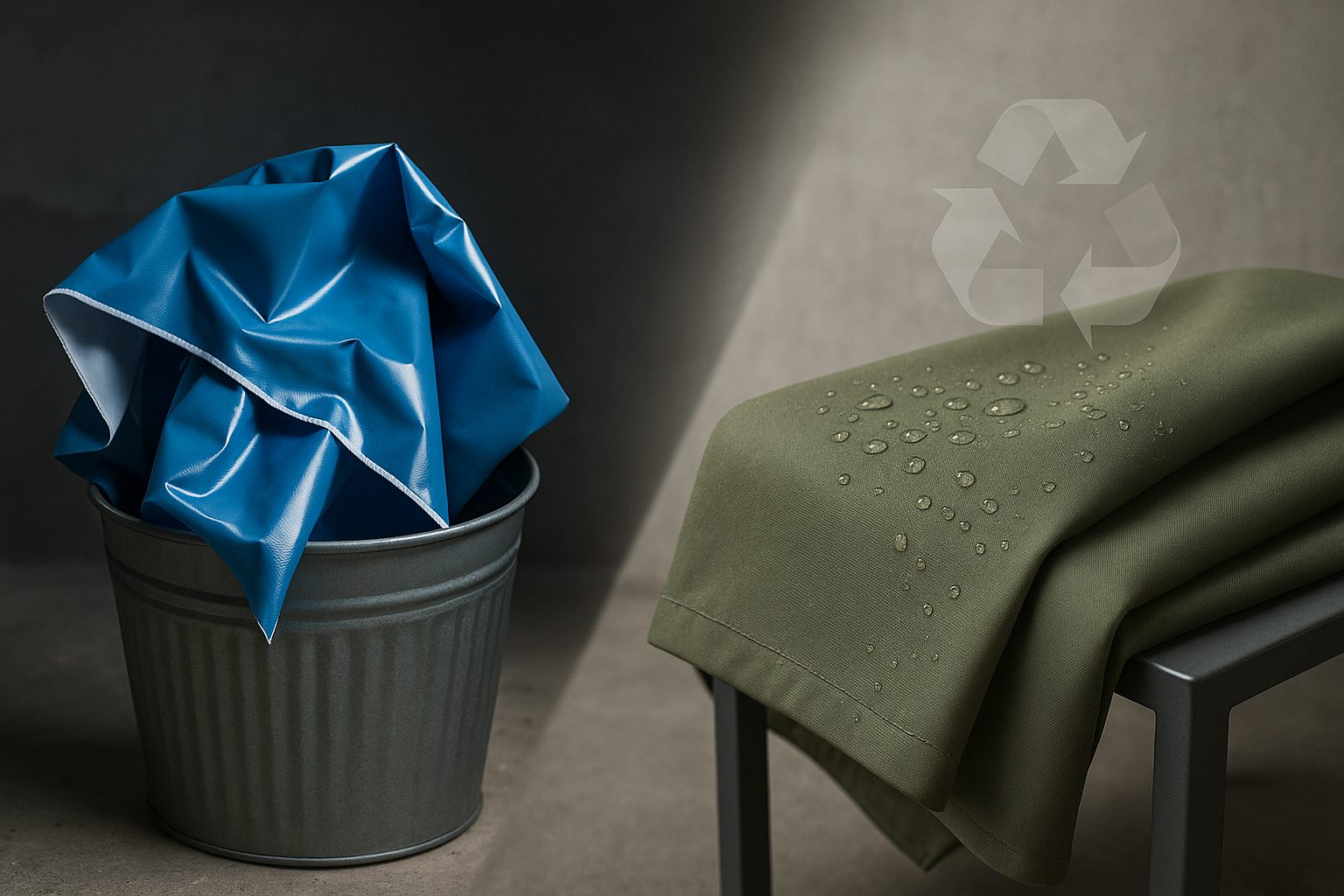
Choosing the right fabric is crucial for your application’s success, and Renegade Plastics offers the cutting-edge waterproof solutions you need.
With our innovative, lightweight, and incredibly durable fabrics, you can achieve superior protection against the elements, chemicals, and wear, all while free of intentionally added PFAS, phthalates, and lead. Don’t compromise on quality or performance; elevate your projects with Renegade’s advanced waterproof technology.
Ready to join the Renegade revolution? Renegade stands by with several lines of polypropylene-based waterproof fabric that outlast and out-perform.
Contact us by phone (920) 348-4554 or complete our online form to discover more about how our waterproof fabrics can be a superior fit for your specific application.
*(Made without intentionally adding per– and polyfluoroalkyl substances, may contain trace amounts.)
Interested in Our Fabrics?
Contact Us